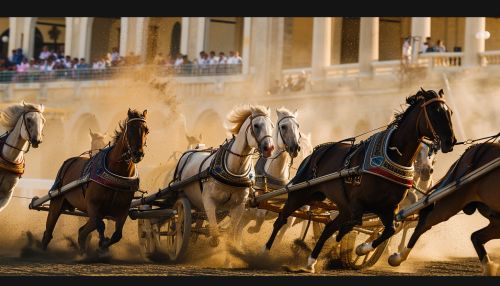Chariot racing
Origins and History
Chariot racing was one of the most popular ancient Greek, Roman and Byzantine sports. Both ancient Greek and Roman civilizations featured chariot racing as an event in the ancient Olympic Games. The sport was dangerous to both drivers and horses as they often suffered serious injury and even death, but these risks added to the excitement and interest for spectators.


Chariots
The chariots themselves were modified war chariots, essentially lightweight carts with two wheels and a small cabin for the driver. The chariot was usually pulled by four horses, although some races saw teams of two or even three horses. The driver, or auriga, stood behind the horses, holding reins tied around his waist to free his hands for the whip and the reins.
Charioteers
Charioteers were often slaves or freedmen. They could become celebrities and amass great wealth if they were successful, but they also faced significant risks. Despite the dangers, charioteers were revered and enjoyed a status similar to modern sports stars.
Racing Circuits
Chariot races were held on a special racing circuit called a Hippodrome. The track was long and narrow with tight turns at each end, making the races exciting and dangerous. The most famous of these circuits was the Hippodrome of Constantinople, which could hold up to 100,000 spectators.
Race Format
Chariot races were typically part of a larger event or festival and could consist of up to 24 races a day. Each race involved multiple teams, each team being identified by color: red, white, blue or green. The races were not just a test of speed, but also of skill and strategy, as charioteers could try to cause their opponents to crash.
Cultural Significance
Chariot racing held a significant place in ancient society. It was a major public entertainment, and its popularity endured for centuries. The sport also had religious and political significance, with races often being sponsored by the state or by wealthy individuals as a demonstration of their power and influence.
Decline and Legacy
Chariot racing declined in popularity after the fall of Rome, but its legacy can still be seen today. The sport influenced later forms of entertainment and sport, such as horse racing and car racing. It also left a mark on language and culture, with phrases like "chariot race" and "hold your horses" still being used today.
